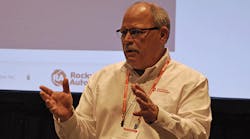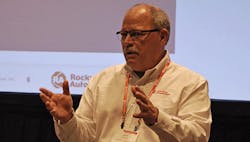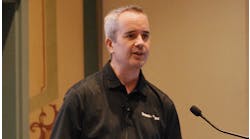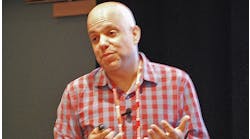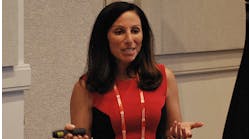How to test capabilities when physical machinery isn’t ready
“The demo can be run on the PanelView or from the pendant that exists in Emulate3D.” Rockwell Automation’s Jeff Theisen, along with colleague Mike Harris, simulated drive capabilities using Emulate3D, FactoryTalk Logix Echo and Studio 5000 Logix Designer.
The ability to simulate machinery for testing can be highly beneficial. “It’s a great thing if you want to test a machine, but they’re not ready for you,” explained Michael Harris, senior project engineer, Rockwell Automation.
He and colleague Jeff Theisen, principal application engineer at Rockwell Automation, demonstrated drive simulation using three software packages—Emulate3D, FactoryTalk Logix Echo and Studio 5000 Logix Designer—during ROKLive 2022 in Orlando, Fla.
“The most exciting thing about this functionality is that I can build my PLC program as if it would be connected to physical hardware and then test it without the devices being present and without having to make any modifications to the project itself,” explained Harris. “This will save countless hours of commissioning time and delays waiting for the machine to become available.”
The technology is a new catalog of Emulate3D, a bunch of aspects created to fulfill the CIP Class 1 connection and “make the yellow triangles go away,” explained Harris. “There are several drives we support—ArmorStart 284E, PowerFlex 525, PowerFlex 75x and PowerFlex 755T drives. This is not a full emulation of the drive. You cannot open the add-on profiles or the control loops, and we only support velocity mode right now,” he said.
“I’m talking about simulating the drive capabilities. The newest drive, the 755TS, is in the TotalForce family. It’s very similar to the 755.”
Included in the firmware for the PowerFlex 755TS is the anti-sway feature, also called anti-slosh, explained Theisen. “It’s important to control the movement. It’s a command notch filter. It’s also used on a bottling line.” The model is created in a CAD package and imported into Emulate3D.
“The demo can be run on the PanelView or from the pendant that exists in Emulate3D,” explained Theisen during his demonstration. “In my Logix program, I’m going to add the drives. You select the drive the same as if it were a physical drive. You bind an aspect to a tag in a visual. You find, for example, the crane. You make a Class 1 connection, which is a CIP protocol in Emulate3D. I can control the drive the same as if it were a physical drive, except I’m programming in Emulate3D.”
Following Theisen’s demo, Harris then created a demonstration from scratch using FactoryTalk Logix Echo. “Assume the hardware’s not ready to test,” he said. “I’ve got my 755TS drive with supported data links. If the drive isn’t configured with the same data links that your project is configured for, you get those yellow triangles.”
FactoryTalk Logix Echo supports the ControlLogix L8 family of CPUs, and it does not support SafetyNet. “Echo takes on the IP address of your Ethernet driver,” explained Harris. “If I click on ‘Add Aspect,’ it’s going to show me every aspect. In 10 minutes, I had this working, or you can go the full-blown model.”
To emulate an unmodified ControlLogix program, Harris executed these high-level steps:
- launch FactoryTalk Logix Echo
- add controller to Echo
- download unmodified application file to emulated controller
- place controller in run mode
- minimize Echo and leave running in the background.
Emulating the drive was equally straightforward:
- launch Emulate3D
- add device (e.g., conveyor) with a motor that the drive can run
- add Allen-Bradley Velocity Drive aspect to the device
- open I/O browser
- add I/O server pointing to the emulated controller
- bind PLC tags to Allen-Bradley Velocity Drive properties
- start I/O server
- play the model.
After completing the 13 steps, Harris started and stopped the drive the same way he would have if it had been a physical drive and trended the drive status, speed feedback and output current to demonstrate that Emulate3D was providing the same information that a physical drive would have provided.
The contrast between what Theisen demonstrated and what Harris demonstrated was to show that the Emulate3D model could be as complex or as simple as required to allow the Logix project to be tested without hardware. “If they have a complex system that requires a complex model with interactions, they can build that,” explained Harris. “If it is a less complicated system, and they only needed a few motors to control, that can be done, as well. The solution is completely scalable, in that they only need to model what is required to be able to verify their code.”
Users don’t need to spend weeks modeling the entire system if it had no impact on the outcome, explained Harris. “I was testing my single drive application in under 20 minutes, and that was going slow so that people could follow along.”
Theisen’s demonstration also showed that, by using Emulate3D, some of the drive functionality can be demonstrated without requiring a larger demo. The reference notch used to demonstrate anti-sway is included out of the box. Other functionality can be implemented by the user by writing custom script.
The editors of Control, Control Design and Smart Industry are reporting live from ROKLive 2022 in Orlando, Florida, to bring you the latest news and insights from the event. When the event comes to a close, the best, most important coverage will be compiled into a report by the editors.
Register now to pre-order the report and be among the first to receive it in your inbox.
